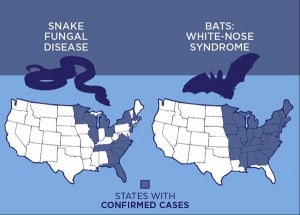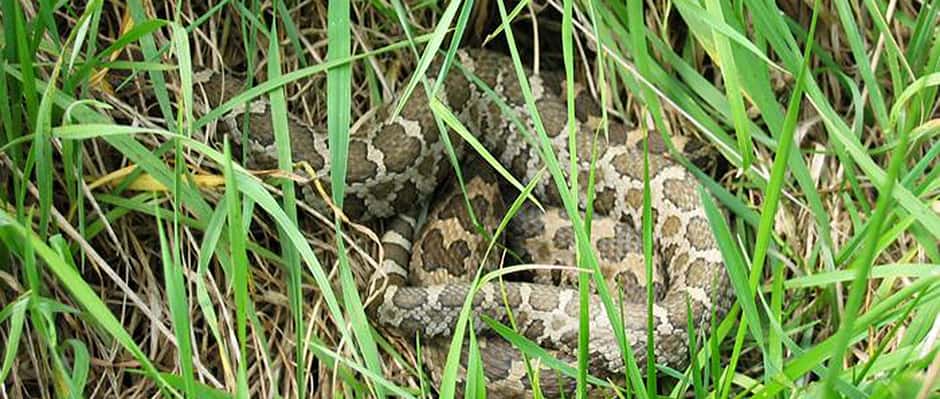Share this article
Resilient Fungus is Deadly Snake Killer
Tracking down snakes for a living can be fun, except when you stumble upon one that’s lost a portion of its face or tail.
Lead author of a recently published study on snake fungal disease in the journal Fungal Ecology Matthew Allender knows this all too well. While Allender was speaking with his colleagues at the Illinois Natural History Survey (INHS) five years ago, they observed three dead Eastern massasauga rattlesnakes (Sistrurus catenatus) that had large abnormalities on their faces. He tested the snakes back in the lab and discovered the fungus that had caused their demise was Ophidiomyces ophiodiicola. Since that point, he and his colleagues have hiked around southern Illinois to find several of these snakes — and many other species — infected by the fungus.

A map of the range of snakes infected with snake fungal disease and bats with white-nose syndrome in the United States is pictured above. Researchers recently found that the fungi that cause the two deadly diseases have similar traits.
Image Credit: Julie McMahon
This deadly fungus appears to now occur in most states east of the Mississippi leaving lesions in infected snakes, some of which are fatal. In fact, researchers have observed a 95 percent mortality rate among infected Eastern massasauga rattlesnakes. It’s also known to target other species of snakes including timber rattlesnakes (Crotalus horridus) black rat snakes (Elaphe obsoleta obsolete) and ribbon snakes (Thamnophis sauritus).
“After we first reported the fungal infections, other populations experiencing similar signs started to be reported,” said Matthew Allender, a clinical assistant professor of zoo and wildlife medicine and a zoo and wildlife veterinarian, who spoke about snake fungal disease at last year’s TWS annual conference in Pittsburgh and at the Illinois Chapter meeting this past spring.
To find out more about the fungus Allender and his team collaborated with a number of biologists and ecologists including members of the INHS. They began by reviewing the historical literature of disease in snakes and studied the ecology of the fungus to understand why it’s so prevalent today. “We looked at if the fungus is really just attacking snakes because it needs them to survive, or if it’s out in the environment and attacking opportunistically,” said Daniel Raudabaugh, the lead co-author of the study and PhD student at the University of Illinois.
As they carried out their research, they found this particular fungus paralleled Pseudogymnoascus destructans — the deadly fungus that causes white-nose syndrome in bats and has wiped out populations across the U.S. And although the two fungi inhabit different ecological niches and thrive in different climates and temperatures, both seem to persist across a range of habitats and infect multiple subspecies of the animal they target, according to the researchers.
The team also found that Ophidiomyces ophiodiicola, which occurs in the soil, can grow on a wide variety of substances and possesses many of the same enzymes present in the white-nose fungus in bats. They also found that, like the bat fungus, the snake fungus can survive on most carbon and nitrogen sources found in soil. “The fungus easily showed capabilities of surviving without any problems,” Raudabaugh said. “It’s quite happy in the environment.”
While the fungus may be happy in its environment, snakes sure aren’t feeling the same way. The deadly fungus consumes keratin, the key ingredient in snake scales causing scabs, nodules, abnormal molting, ulcers and other skin issues.
Further, the snake fungus doesn’t need the snakes to survive, but is attacking the reptiles anyway. The reason for this is something the team agrees needs to be studied further. “This is one of the major issues,” Raudabaugh said. “We want to find out whether the snakes are currently becoming more susceptible or if we are just now noticing it.”
Raudabaugh said that he wants to make sure that the fungus, which currently only resides in the U.S., as far as they know, doesn’t spread to other countries as the white-nose fungus has been transported from Europe to North America. Meanwhile, Allender said there is no indication that snake trade did or did not cause the disease to spread to begin with. “It is too early to speculate on where the fungus came from, but it is widespread and does not currently appear to me to have been introduced recently in a single location,” he said. However, Raudabaugh and Allender both agree that it is important to be careful about spreading the fungus further.
Snake Conservation
Allender said the important thing in saving snakes and other reptiles is to take note of not only snake fungal disease, but of other diseases and factors that impact them as well, including habitat loss and fragmentation, altered landscapes, and changes in water patterns to name a few. “We should not only focus only on diseases we know, but be vigilant in diagnosing and investigating diseases that are yet undiscovered,” he added.
Meanwhile, the researchers are looking for answers as to why the disease is becoming so prevalent as well as what some possible cures may be. So far, they have tried altering temperatures and humidity and maintaining a good environment, and giving them antifungal medication either orally or topically. “No one treatment has been terribly effective,” Allender said. “There are variable responses.”
With this research, however, Allender hopes to attract more interest to reptiles and the problems they face. “They are an underappreciated taxa,” he said. “And in a lot of ways, we know very little about them. My job and goals are to bring attention to those, and doing research to save populations and animals.”
Header Image:
An eastern massasauga rattlesnake slithers through the grass. An emerging snake fungal disease threatens a wide range of snake species including this one.
Image Credit: Matthew Allender








